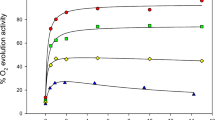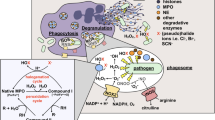Abstract
A proton caged compound, the 1-(2-nitrophenyl)- ethylhexadecyl sulfonate (HDNS), was dosed into HEK-293 at different incubation times. Samples were irradiated with filtered UV light for inducing photolysis of the HDNS and then probed by infrared spectroscopy. The intracellular acidification reaction can be followed by monitoring the consequent CO2 peak intensity variation. The total CO2 produced is similar for all the samples, hence it is only a function of the initial HDNS concentration. The way it is achieved, though, is different for the different incubation times and follows kinetics, which results in a combination of a linear CO2 increase and a steep CO2 increase followed by a decay. This is interpreted in terms of confinement of the HDNS into intracellular vesicles of variable average size and sensitive to UV light when they reach critical dimensions.

Similar content being viewed by others
References
Boron WF (2004) Regulation of intracellular pH Adv. Physiol Educ 28:160–179
Boron WF, Boulpaep EL (1983) Intracellular pH regulation in the renal proximal tubule of the salamander. Basolateral HCO3 − transport. J Gen Physiol 81:53–94
Bourque CW (2008) Central mechanisms of osmosensation and systemic osmoregulation. Nat Rev Neurosci 9:519–531
Carbone M, Zlateva T, Quaroni L (2013) Monitoring and manipulation of the pH of single cells using infrared spectromicroscopy and a molecular switch. Biochim Biophys Acta Gen Subj 1830(4):2989–2993
Chegwidden WR, Dodgson SJ, Spencer IM (2000) The roles of carbonic anhydrase in metabolism cell growth and cancer in animals. Carbonic Anhydrases EXS 90(90):343–363
Chiche J, Brahimi-Horn MC, Pouysségur J (2010) Tumour hypoxia induces a metabolic shift causing acidosis: a common feature in cancer. J Cell Mol Med 14:771–794
Choi I, Aalkjaer C, Boulpaep EL, Boron WF (2000) An electroneutral sodium/bicarbonate cotransporter NBCn1 and associated sodium channel. Nature 405:571–575
Dean RT, Jessup W, Roberts CR (1984) Effects of exogenous amines on mammalian cells, with particular reference to membrane flow. Biochem J 217:27–40
Deitmer JW, Schlue WR (1989) An inwardly directed electrogenic sodium-bicarbonate co-transport in leech glial cells. J Physiol 411:179–194
Dodgson SJ, Forster RE II, Storey BT, Mela L (1980) Mitochondrial carbonic anhydrase. Proc Natl Acad Sci USA 77(9):5562–5566
Endeward V, Cartron JP, Ripoche P, Gros G (2008) RhAG protein of the Rhesus complex is a CO2 channel in the human red cell membrane. FASEB J. 22:64–73
Finbow ME, Harrison MA (1997) The vacuolar H+-ATPase: a universal proton pump of eukaryotes. Biochem J 324:697–712
Gutman M, Dan Huppert P, Pined E (1981) The pH jump: a rapid modulation of pH of aqueous solutions by a laser pulse. J Am Chem Soc 103:3709–3713
Harvey BJ, Eherenfeld J (1988) Role of Na exchange in the control of intracellular pH and cell membrane conductances in frog skin epithelium. J Gen Physiol 92:793–810
Hulikova A, Vaughan-Jones RD, Swietach P (2011) Dual role of CO2/HCO3 − buffer in the regulation of intracellular pH of three-dimensional tumor growths. J Biol Chem 286(16):13815–13826
Itel F, Al-Samir S, Öberg F, Chami M, Kumar M, Supuran CT, Deen PMT, Meier W, Hedfalk K, Gros G, Endeward V (2012) CO2 permeability of cell membranes is regulated by membrane cholesterol and protein gas channels. FASEB J. 26:5182–5191
Kabalka GW, Varma M, Varma RS, Srivastava PC, Knapp FF Jr (1986) Tosylation of alcohols. J Org Chem 51(12):2386–2388
Kustu S, Inwood W (2006) Biological gas channels for NH3 and CO2: evidence that Rh (Rhesus) proteins are CO2 channels. Transfus Clin Biol 13:103–110
Lagadic-Gossmann D, Huc L, Lecureur V (2004) Alterations of intracellular pH homeostasis in apoptosis: origins and roles. Cell Death Differ 11:953–961
Marrink SJ, Mark AE (2003) The mechanism of vesicle fusion as revealed by molecular dynamics simulations. J Am Chem Soc 125:11144–11145
Obara M, Szeliga M, Albrecht J (2008) Regulation of pH in the mammalian central nervous system under normal and pathological conditions: facts and hypotheses. Neurochem Int 52(6):905–919
Orlowski J, Kandasamy RA, Shull GE (1992) Molecular cloning of putative members of the Na/H exchanger gene family. J Biol Chem 267(13):9331–9339
Overton E (1895) Über die osmotischen Eigenschaftender lebenden Pflanzen und Tierzelle. Vierteljahrsschr Naturforsch Ges Zürich 40:159–201
Pedersen PL, Carafoli E (1987) Ion motive ATPases. Ubiquity, properties, and significance to cell function. Trends Biochem Sci 12:146–150
Pornpattananangkul D, Olson S, Aryal S, Sartor M, Huang C-M, Vecchio K, Zhang L (2010) Stimuli-responsive liposome fusion mediated by gold nanoparticles. ACS Nano 4:1935–1942
Pouysségur J, Sardet C, Franchi A, L’Allemain G, Paris S (1984) A specific mutation abolishing Na+/H+ antiport activity in hamster fibroblasts precludes growth at neutral and acidic pH. Proc Natl Acad Sci 81:4833–4837
Romero MF, Hediger MA, Boulpaep EL, Boron WF (1997) Expression cloning and characterization of a renal electrogenic Na+/HCO3 − cotransporter. Nature 387:409–413
Romero MF, Henry D, Nelson S, Harte PJ, Dillon AK, Sciortino CM (2000) Cloning and characterization of a Na+ driven anion exchanger (NDAE1): a new bicarbonate transporter. J Biol Chem 275:24552–24559
Schulz KG, Riebesell U, Rost B, Thoms S, Zeebe RE (2006) Determination of the rate constants for the carbon dioxide to bicarbonate inter-conversion in pH-buffered seawater systems. Mar Chem 100:53–65
Soulet D, Gagnon B, Rivest S, Audette M, Paulin R (2004) A fluorescent probe of polyamine transport accumulates into intracellular acidic vesicles via a two-step mechanism. J Biol Chem 279:49355–49366
Thwaites DT, Anderson CMH (2007) H+-coupled nutrient, micronutrient and drug transporters in the mammalian small intestine. Exp Physiol 92(4):603–619
Wang CZ, Yano H, Nagashima K, Seino S (2000) The Na+-driven Cl−/HCO3 − exchanger. J Biol Chem 275:35486–35490
Wong P, Kleemann HW, Tannock IF (2002) Cytostatic potential of novel agents that inhibit the regulation of intracellular pH. Br J Cancer 87:238–245
Author information
Authors and Affiliations
Corresponding author
Electronic supplementary material
Below is the link to the electronic supplementary material.
Rights and permissions
About this article
Cite this article
Carbone, M., Sabbatella, G., Antonaroli, S. et al. Modulating intracellular acidification by regulating the incubation time of proton caged compounds. Eur Biophys J 45, 565–571 (2016). https://doi.org/10.1007/s00249-016-1122-5
Received:
Revised:
Accepted:
Published:
Issue Date:
DOI: https://doi.org/10.1007/s00249-016-1122-5




